|
9484| 2
|
[项目] Arduino项目|仿真蜡烛 |
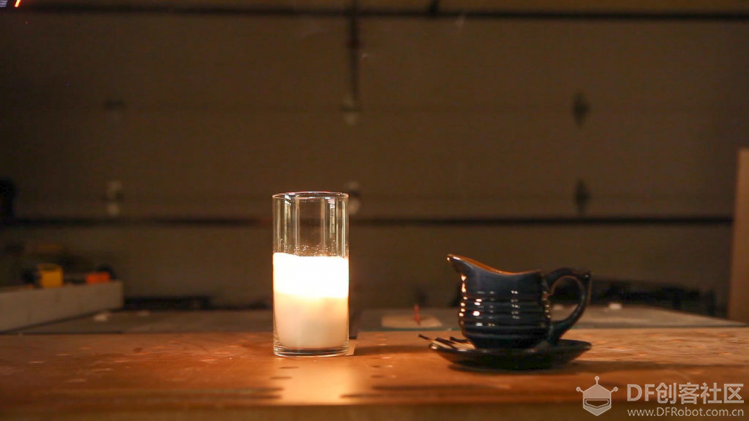 “Keith's Test Garage”想要一支LED蜡烛。虽然已经有了一些很逼真的项目,而且很容易找到,但他正在寻找更像实际的东西,经过几年的工作后,他们想出了一个相当惊人的复制品。  该设备的蜡嵌入式玻璃外壳内装有Arduino,内置一系列六个RGBW LED,随机闪烁以模拟火焰。 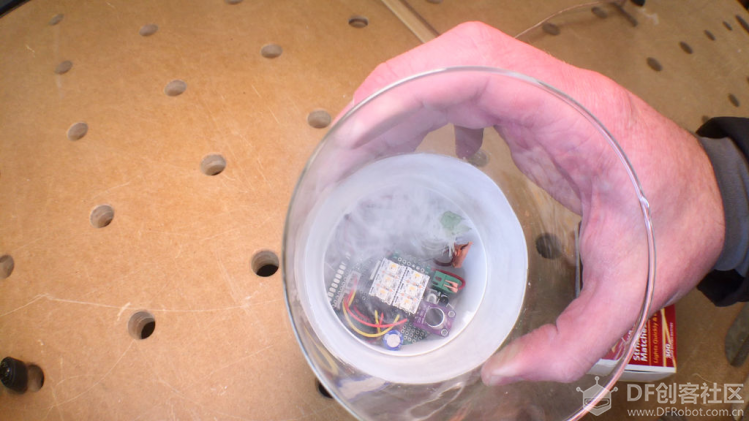 下面把原作者的相关代码和连线图分享出来了 代码: [mw_shl_code=applescript,true]<p>// FIRST TEST OF MIC AND FLAME SENSOR<br>// Keith Kelly 2019-03-04 <a href="http://www.KeithsTestGarage.com"> www.KeithsTestGarage.com </a> // Milestone 1 of 3</p><p>#define MIC_PIN A1 // Microphone Pin #define FLAME_PIN A3 // IR Sensor Pin</p><p>#define FLAME_DURATION 2000 // millis- duration of flame before lighting candle #define FLAME_THRESHOLD 800 // 0...1023 - analog reading of FLAME value to detect #define MIC_THRESHOLD 950 // 0...1023 - analog reading of MIC value to detect</p><p>// Vars to keep track of things bool smoking = false; bool flaming = false;</p><p>bool lit = false; int flame_val = 0; int mic_val = 0;</p><p>// Vars for tracking pseudo-async times unsigned long previousMillis = 0; // will store last time LED was updated unsigned long flameStartedMillis = 0; // will store last time LED was updated</p><p>void setup(){</p><p> Serial.begin(9600); // uncomment this to figure sensor readings.</p><p> // initialize pins pinMode(FLAME_PIN, INPUT); pinMode(MIC_PIN, INPUT); pinMode(LED_BUILTIN, OUTPUT); </p><p> digitalWrite(LED_BUILTIN, LOW); // Turn OFF built-in LED</p><p> blowOutCandle(); // Make sure candle is off (but don't smoke)</p><p>}</p><p>void loop(){ checkSensors(); // Check for fire and strong winds }</p><p>// Checks for fire and strong winds every 50 milliseconds void checkSensors(){ unsigned long currentMillis = millis(); if (currentMillis - previousMillis >= 50) { // only check every 50ms flame_val = analogRead( FLAME_PIN ); mic_val = analogRead( MIC_PIN ); previousMillis = currentMillis; // Uncomment below to check sensor readings. Serial.print(mic_val); Serial.print(" : "); Serial.println(flame_val); }</p><p> if (lit && mic_val > MIC_THRESHOLD){ // MIC REGISTERED SOUND. BLOW OUT. blowOutCandle(); // Turn off light (and start SMOKING!) lit = false; }</p><p> if (!lit){ // if candle isn't lit if (flame_val > FLAME_THRESHOLD) { // if flame is detected // record the starting time (if flame not yet detected) if (!flaming){ // if not flaming flaming = true; flameStartedMillis = millis(); // record time that flaming begins } else if (checkFlame()){ // has flame been flaming long enough? lightCandle(); // ok finally light it up. lit = true; } } else{ // no flame detected flaming = false; } } }</p><p>// Check if flame has been detected long enough. bool checkFlame(){ unsigned long currentMillis = millis(); // get current time if (currentMillis - flameStartedMillis >= FLAME_DURATION) { return true; } else return false; }</p><p>// (pseudo)ASYNC light the candle by starting the animations void lightCandle(){ digitalWrite(LED_BUILTIN, HIGH); }</p><p>void blowOutCandle(){ digitalWrite(LED_BUILTIN, LOW); }</p>[/mw_shl_code] [mw_shl_code=applescript,true]// Using technique from here https://learn.adafruit.com/multi-tasking-the-ardu... // see link above for a good tutorial on this multi-task-ish way of doing things. // Flicker Realistic Candle // Keith Kelly 2019-03-04 www.KeithsTestGarage.com // Milestone 2 of 3 #ifdef __AVR__ #include #endif // NeoPatterns will require the Adafruit NeoPixel library. Be sure to install that. #include "NeoPatterns.h" #define NEO_PIN 5 // First RGBW Strip Pin #define NEO2_PIN 9 // Second RGBW Strip Pin #define NEO_COUNT 3 // First RGBW Strip Count #define NEO2_COUNT 3 // Second RGBW Strip Count #define MIC_PIN A1 // Microphone Pin #define FLAME_PIN A3 // IR Sensor Pin #define FLAME_DURATION 2000 // millis- duration of flame before lighting candle #define FLAME_THRESHOLD 800 // 0...1023 - analog reading of FLAME value to detect #define MIC_THRESHOLD 950 // 0...1023 - analog reading of MIC value to detect void Strip1Complete(); void Strip2Complete(); NeoPatterns Strip1(NEO_COUNT, NEO_PIN, NEO_RGBW + NEO_KHZ800, &Strip1Complete); NeoPatterns Strip2(NEO_COUNT, NEO2_PIN, NEO_RGBW + NEO_KHZ800, &Strip2Complete); uint32_t baseColor; // What is the ON resting color? uint32_t offColor; // What is the OFF resting color? // Vars to keep track of things bool flaming = false; bool lit = false; int flame_val = 0; int mic_val = 0; byte rnd = 0; // Vars for tracking pseudo-async times unsigned long previousMillis = 0; // will store last time LED was updated unsigned long flameStartedMillis = 0; // will store last time LED was updated void setup(){ //Serial.begin(9600); // uncomment this to figure sensor readings. // initialize pins pinMode(FLAME_PIN, INPUT); pinMode(MIC_PIN, INPUT); pinMode(LED_BUILTIN, OUTPUT); // Make sure the following pins are OFF digitalWrite(LED_BUILTIN, LOW); // Initialize NeoPixel Strip 1 Strip1.begin(); Strip1.show(); baseColor = Strip1.Color(2, 110, 0, 100);// GRBW Strip1.Color1 = baseColor; // Initialize NeoPixel Strip 2 Strip2.begin(); Strip2.show(); baseColor = Strip2.Color(2, 110, 0, 100);// GRBW Strip2.Color1 = baseColor; blowOutCandle(); // Make sure candle is off } void loop(){ checkSensors(); // Check for fire and strong winds Strip1.Update(); Strip2.Update(); } // Checks for fire and strong winds every 50 milliseconds void checkSensors(){ unsigned long currentMillis = millis(); if (currentMillis - previousMillis >= 50) { // only check every 50ms flame_val = analogRead( FLAME_PIN ); mic_val = analogRead( MIC_PIN ); previousMillis = currentMillis; // Uncomment below to check sensor readings. // Serial.print(mic_val); // Serial.print(" : "); // Serial.println(flame_val); } if (lit && mic_val > MIC_THRESHOLD){ // MIC REGISTERED SOUND. BLOW OUT. blowOutCandle(); // Turn off light lit = false; } if (!lit){ // if candle isn't lit if (flame_val > FLAME_THRESHOLD) { // if flame is detected // record the starting time (if flame not yet detected) if (!flaming){ // if not flaming flaming = true; flameStartedMillis = millis(); // record time that flaming begins } else if (checkFlame()){ // has flame been flaming long enough? lightCandle(); // ok finally light it up. lit = true; } } else{ // no flame detected flaming = false; } } } // Check if flame has been detected long enough. bool checkFlame(){ unsigned long currentMillis = millis(); // get current time if (currentMillis - flameStartedMillis >= FLAME_DURATION) { return true; } else return false; } //------------------------------------------------------------ //Completion Routines - get called on completion of a pattern //------------------------------------------------------------ // The below configuration routines are the same except for the strip // being used. I kept them separate so the strips can be configured // with different ranges if desired. void Strip1Complete(){ Strip1.Reverse(); if (Strip1.Direction == REVERSE){ // go back down Strip1.Interval = random(5,22); // choose random speed in range } else{ // pattern ended. Stop, then trigger re-flicker /* This needs an explanation: rnd = random(random(45,55),random(80,255)); You'd think that we could just do random(45,255), right? Selecting the low and high randoms first helps make sure that the ending random number is *more likely* to fall within a limited range. When observing the flickering of a real candle, the flame generally bounces around in a certain range. But, every once in a while, it spikes high or low. This random(random, random) solves that problem! #proudnerddadmoment */ rnd = random(random(45,55),random(80,255)); Strip1.Pixel = random(0,Strip1.numPixels()); // pick a random Pixel Strip1.Interval = 1; Strip1.Color2 = Strip1.Color(2,rnd,0,rnd-10); //GRBW random red and random white-10 } } void Strip2Complete(){ Strip2.Reverse(); if (Strip2.Direction == REVERSE){ // go back down Strip2.Interval = random(5,22); // choose random speed in range } else{ // pattern ended. Stop, then trigger re-flicker rnd = random(random(45,55),random(80,255)); // see explanation in Strip1Complete(). Strip2.Pixel = random(0,Strip2.numPixels()); // pick a random Pixel Strip2.Interval = 1; Strip2.Color2 = Strip2.Color(2,rnd,0,rnd-10); //GRBW random red and random white-10 } } // (pseudo)ASYNC light the candle by starting the animations void lightCandle(){ Strip1.Flicker(Strip1.Color1, Strip1.Color2, 20, 5); Strip2.Flicker(Strip2.Color1, Strip2.Color2, 20, 5); } void blowOutCandle(){ cWipe(offColor, 10); // synchronously turn the candle off. // We don't want no stinking patterns. Strip1.ActivePattern = NONE; Strip2.ActivePattern = NONE; } // synchronous color wipe void cWipe(uint32_t c, uint8_t wait) { for (uint16_t i = 0; i < Strip1.numPixels(); i++) { Strip1.setPixelColor(i, c); Strip1.show(); delay(wait); } for (uint16_t i = 0; i < Strip2.numPixels(); i++) { Strip2.setPixelColor(i, c); Strip2.show(); delay(wait); } }[/mw_shl_code] [mw_shl_code=applescript,true][Code segment omitted for clarity. See attached file.] // ***************************************** // START Custom animation for LED candle // ***************************************** // Initialize for a Flicker void Flicker(uint32_t color1, uint32_t color2, uint16_t steps, uint8_t interval, direction dir = FORWARD) { ActivePattern = FLICKER; Interval = interval; TotalSteps = steps; Color1 = color1; Color2 = color2; Index = 0; Direction = dir; Pixel = random(0,numPixels()); // random(min,max) --max is EXCLUSIVE } // Initialize for a Flicker void FlickerUpdate() { // Calculate linear interpolation between Color1 and Color2 // Optimize order of operations to minimize truncation error uint8_t red = ((Red(Color1) * (TotalSteps - Index)) + (Red(Color2) * Index)) / TotalSteps; uint8_t green = ((Green(Color1) * (TotalSteps - Index)) + (Green(Color2) * Index)) / TotalSteps; uint8_t blue = ((Blue(Color1) * (TotalSteps - Index)) + (Blue(Color2) * Index)) / TotalSteps; uint8_t white = ((White(Color1) * (TotalSteps - Index)) + (White(Color2) * Index)) / TotalSteps; setPixelColor(Pixel,Color(red, green, blue, white)); show(); Increment(); } // ***************************************** // END Custom animation for LED candle // ***************************************** [Code segment omitted for clarity. See attached file.] Attachments KeithsCandle_M2_NoSmoke.inoKeithsCandle_M2_NoSmoke.ino[/mw_shl_code] 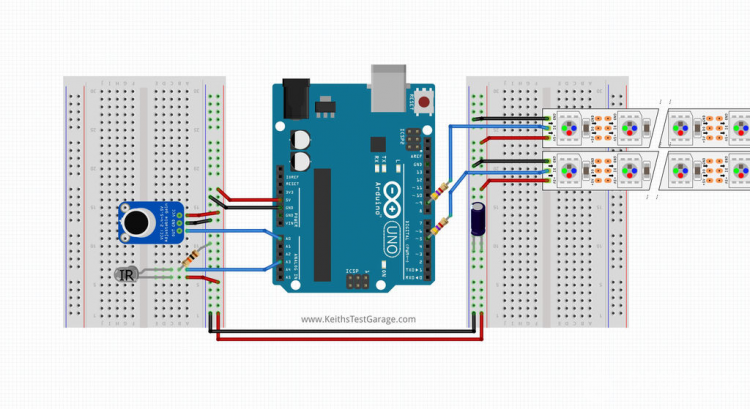 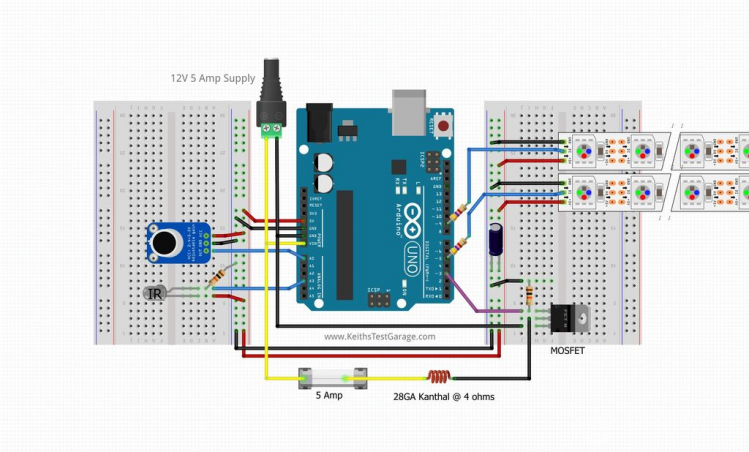 [mw_shl_code=applescript,true]// Using technique from here https://learn.adafruit.com/multi-tasking-the-ardu... // see link above for a good tutorial on this multi-task-ish way of doing things. // Flicker Realistic Candle // Keith Kelly 2019-03-04 www.KeithsTestGarage.com // Milestone 2 of 3 #ifdef __AVR__ #include #endif // NeoPatterns will require the Adafruit NeoPixel library. Be sure to install that. #include "NeoPatterns.h" #define NEO_PIN 5 // First RGBW Strip Pin #define NEO2_PIN 9 // Second RGBW Strip Pin #define NEO_COUNT 3 // First RGBW Strip Count #define NEO2_COUNT 3 // Second RGBW Strip Count #define MIC_PIN A1 // Microphone Pin #define FLAME_PIN A3 // IR Sensor Pin #define FLAME_DURATION 2000 // millis- duration of flame before lighting candle #define FLAME_THRESHOLD 800 // 0...1023 - analog reading of FLAME value to detect #define MIC_THRESHOLD 950 // 0...1023 - analog reading of MIC value to detect void Strip1Complete(); void Strip2Complete(); NeoPatterns Strip1(NEO_COUNT, NEO_PIN, NEO_RGBW + NEO_KHZ800, &Strip1Complete); NeoPatterns Strip2(NEO_COUNT, NEO2_PIN, NEO_RGBW + NEO_KHZ800, &Strip2Complete); uint32_t baseColor; // What is the ON resting color? uint32_t offColor; // What is the OFF resting color? // Vars to keep track of things bool flaming = false; bool lit = false; int flame_val = 0; int mic_val = 0; byte rnd = 0; // Vars for tracking pseudo-async times unsigned long previousMillis = 0; // will store last time LED was updated unsigned long flameStartedMillis = 0; // will store last time LED was updated void setup(){ //Serial.begin(9600); // uncomment this to figure sensor readings. // initialize pins pinMode(FLAME_PIN, INPUT); pinMode(MIC_PIN, INPUT); pinMode(LED_BUILTIN, OUTPUT); // Make sure the following pins are OFF digitalWrite(LED_BUILTIN, LOW); // Initialize NeoPixel Strip 1 Strip1.begin(); Strip1.show(); baseColor = Strip1.Color(2, 110, 0, 100);// GRBW Strip1.Color1 = baseColor; // Initialize NeoPixel Strip 2 Strip2.begin(); Strip2.show(); baseColor = Strip2.Color(2, 110, 0, 100);// GRBW Strip2.Color1 = baseColor; blowOutCandle(); // Make sure candle is off } void loop(){ checkSensors(); // Check for fire and strong winds Strip1.Update(); Strip2.Update(); } // Checks for fire and strong winds every 50 milliseconds void checkSensors(){ unsigned long currentMillis = millis(); if (currentMillis - previousMillis >= 50) { // only check every 50ms flame_val = analogRead( FLAME_PIN ); mic_val = analogRead( MIC_PIN ); previousMillis = currentMillis; // Uncomment below to check sensor readings. // Serial.print(mic_val); // Serial.print(" : "); // Serial.println(flame_val); } if (lit && mic_val > MIC_THRESHOLD){ // MIC REGISTERED SOUND. BLOW OUT. blowOutCandle(); // Turn off light lit = false; } if (!lit){ // if candle isn't lit if (flame_val > FLAME_THRESHOLD) { // if flame is detected // record the starting time (if flame not yet detected) if (!flaming){ // if not flaming flaming = true; flameStartedMillis = millis(); // record time that flaming begins } else if (checkFlame()){ // has flame been flaming long enough? lightCandle(); // ok finally light it up. lit = true; } } else{ // no flame detected flaming = false; } } } // Check if flame has been detected long enough. bool checkFlame(){ unsigned long currentMillis = millis(); // get current time if (currentMillis - flameStartedMillis >= FLAME_DURATION) { return true; } else return false; } //------------------------------------------------------------ //Completion Routines - get called on completion of a pattern //------------------------------------------------------------ // The below configuration routines are the same except for the strip // being used. I kept them separate so the strips can be configured // with different ranges if desired. void Strip1Complete(){ Strip1.Reverse(); if (Strip1.Direction == REVERSE){ // go back down Strip1.Interval = random(5,22); // choose random speed in range } else{ // pattern ended. Stop, then trigger re-flicker /* This needs an explanation: rnd = random(random(45,55),random(80,255)); You'd think that we could just do random(45,255), right? Selecting the low and high randoms first helps make sure that the ending random number is *more likely* to fall within a limited range. When observing the flickering of a real candle, the flame generally bounces around in a certain range. But, every once in a while, it spikes high or low. This random(random, random) solves that problem! #proudnerddadmoment */ rnd = random(random(45,55),random(80,255)); Strip1.Pixel = random(0,Strip1.numPixels()); // pick a random Pixel Strip1.Interval = 1; Strip1.Color2 = Strip1.Color(2,rnd,0,rnd-10); //GRBW random red and random white-10 } } void Strip2Complete(){ Strip2.Reverse(); if (Strip2.Direction == REVERSE){ // go back down Strip2.Interval = random(5,22); // choose random speed in range } else{ // pattern ended. Stop, then trigger re-flicker rnd = random(random(45,55),random(80,255)); // see explanation in Strip1Complete(). Strip2.Pixel = random(0,Strip2.numPixels()); // pick a random Pixel Strip2.Interval = 1; Strip2.Color2 = Strip2.Color(2,rnd,0,rnd-10); //GRBW random red and random white-10 } } // (pseudo)ASYNC light the candle by starting the animations void lightCandle(){ Strip1.Flicker(Strip1.Color1, Strip1.Color2, 20, 5); Strip2.Flicker(Strip2.Color1, Strip2.Color2, 20, 5); } void blowOutCandle(){ cWipe(offColor, 10); // synchronously turn the candle off. // We don't want no stinking patterns. Strip1.ActivePattern = NONE; Strip2.ActivePattern = NONE; } // synchronous color wipe void cWipe(uint32_t c, uint8_t wait) { for (uint16_t i = 0; i < Strip1.numPixels(); i++) { Strip1.setPixelColor(i, c); Strip1.show(); delay(wait); } for (uint16_t i = 0; i < Strip2.numPixels(); i++) { Strip2.setPixelColor(i, c); Strip2.show(); delay(wait); } }[/mw_shl_code] [mw_shl_code=applescript,true][Code segment omitted for clarity. See attached file.] // ***************************************** // START Custom animation for LED candle // ***************************************** // Initialize for a Flicker void Flicker(uint32_t color1, uint32_t color2, uint16_t steps, uint8_t interval, direction dir = FORWARD) { ActivePattern = FLICKER; Interval = interval; TotalSteps = steps; Color1 = color1; Color2 = color2; Index = 0; Direction = dir; Pixel = random(0,numPixels()); // random(min,max) --max is EXCLUSIVE } // Initialize for a Flicker void FlickerUpdate() { // Calculate linear interpolation between Color1 and Color2 // Optimize order of operations to minimize truncation error uint8_t red = ((Red(Color1) * (TotalSteps - Index)) + (Red(Color2) * Index)) / TotalSteps; uint8_t green = ((Green(Color1) * (TotalSteps - Index)) + (Green(Color2) * Index)) / TotalSteps; uint8_t blue = ((Blue(Color1) * (TotalSteps - Index)) + (Blue(Color2) * Index)) / TotalSteps; uint8_t white = ((White(Color1) * (TotalSteps - Index)) + (White(Color2) * Index)) / TotalSteps; setPixelColor(Pixel,Color(red, green, blue, white)); show(); Increment(); } // ***************************************** // END Custom animation for LED candle // ***************************************** [Code segment omitted for clarity. See attached file.][/mw_shl_code] 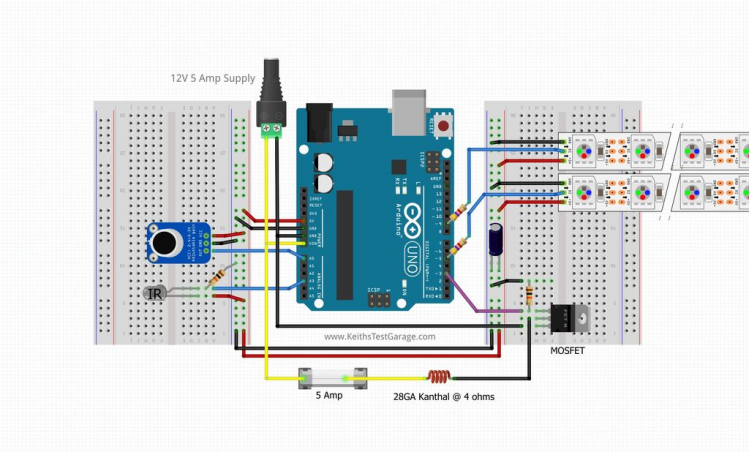 [mw_shl_code=applescript,true]// Using technique from here https://learn.adafruit.com/multi-tasking-the-ardu... // see link above for a good tutorial on this multi-task-ish way of doing things. // Flicker/Smoke Realistic Candle // Keith Kelly 2019-03-04 www.KeithsTestGarage.com // Milestone 3 of 3 #ifdef __AVR__ #include #endif // NeoPatterns will require the Adafruit NeoPixel library. Be sure to install that. #include "NeoPatterns.h" #define NEO_PIN 5 // First RGBW Strip Pin #define NEO2_PIN 9 // Second RGBW Strip Pin #define NEO_COUNT 3 // First RGBW Strip Count #define NEO2_COUNT 3 // Second RGBW Strip Count #define MIC_PIN A1 // Microphone Pin #define FLAME_PIN A3 // IR Sensor Pin #define SMOKE_PIN 3 // Smoke Pin #define SMOKE_TIME_MILLIS 1200 // How long should smoke wire be heated? #define FLAME_DURATION 2000 // millis- duration of flame before lighting candle #define FLAME_THRESHOLD 800 // 0...1023 - analog reading of FLAME value to detect #define MIC_THRESHOLD 950 // 0...1023 - analog reading of MIC value to detect void Strip1Complete(); void Strip2Complete(); NeoPatterns Strip1(NEO_COUNT, NEO_PIN, NEO_RGBW + NEO_KHZ800, &Strip1Complete); NeoPatterns Strip2(NEO_COUNT, NEO2_PIN, NEO_RGBW + NEO_KHZ800, &Strip2Complete); uint32_t baseColor; // What is the ON resting color? uint32_t offColor; // What is the OFF resting color? // Vars to keep track of things bool smoking = false; bool flaming = false; bool lit = false; int flame_val = 0; int mic_val = 0; byte rnd = 0; // Vars for tracking pseudo-async times unsigned long previousMillis = 0; // will store last time LED was updated unsigned long smokeStartedMillis = 0; // time smoking started unsigned long flameStartedMillis = 0; // will store last time LED was updated void setup(){ //Serial.begin(9600); // uncomment this to figure sensor readings. // initialize pins pinMode(FLAME_PIN, INPUT); pinMode(MIC_PIN, INPUT); pinMode(SMOKE_PIN, OUTPUT); pinMode(LED_BUILTIN, OUTPUT); // Make sure the following pins are OFF digitalWrite(SMOKE_PIN, LOW); digitalWrite(LED_BUILTIN, LOW); // Initialize NeoPixel Strip 1 Strip1.begin(); Strip1.show(); baseColor = Strip1.Color(2, 110, 0, 100);// GRBW Strip1.Color1 = baseColor; // Initialize NeoPixel Strip 2 Strip2.begin(); Strip2.show(); baseColor = Strip2.Color(2, 110, 0, 100);// GRBW Strip2.Color1 = baseColor; blowOutCandle(false); // Make sure candle is off (but don't smoke) } void loop(){ smokeCheck(); // Check if we should stop smoking. checkSensors(); // Check for fire and strong winds Strip1.Update(); Strip2.Update(); } // Checks for fire and strong winds every 50 milliseconds void checkSensors(){ unsigned long currentMillis = millis(); if (currentMillis - previousMillis >= 50) { // only check every 50ms flame_val = analogRead( FLAME_PIN ); mic_val = analogRead( MIC_PIN ); previousMillis = currentMillis; // Uncomment below to check sensor readings. // Serial.print(mic_val); // Serial.print(" : "); // Serial.println(flame_val); } if (lit && mic_val > MIC_THRESHOLD){ // MIC REGISTERED SOUND. BLOW OUT. blowOutCandle(true); // Turn off light (and start SMOKING!) lit = false; } if (!lit){ // if candle isn't lit if (flame_val > FLAME_THRESHOLD) { // if flame is detected // record the starting time (if flame not yet detected) if (!flaming){ // if not flaming flaming = true; flameStartedMillis = millis(); // record time that flaming begins } else if (checkFlame()){ // has flame been flaming long enough? lightCandle(); // ok finally light it up. lit = true; } } else{ // no flame detected flaming = false; } } } // Check if flame has been detected long enough. bool checkFlame(){ unsigned long currentMillis = millis(); // get current time if (currentMillis - flameStartedMillis >= FLAME_DURATION) { return true; } else return false; } //------------------------------------------------------------ //Completion Routines - get called on completion of a pattern //------------------------------------------------------------ // The below configuration routines are the same except for the strip // being used. I kept them separate so the strips can be configured // with different ranges if desired. void Strip1Complete(){ Strip1.Reverse(); if (Strip1.Direction == REVERSE){ // go back down Strip1.Interval = random(5,22); // choose random speed in range } else{ // pattern ended. Stop, then trigger re-flicker /* This needs an explanation: rnd = random(random(45,55),random(80,255)); You'd think that we could just do random(45,255), right? Selecting the low and high randoms first helps make sure that the ending random number is *more likely* to fall within a limited range. When observing the flickering of a real candle, the flame generally bounces around in a certain range. But, every once in a while, it spikes high or low. This random(random, random) solves that problem! #proudnerddadmoment */ rnd = random(random(45,55),random(80,255)); Strip1.Pixel = random(0,Strip1.numPixels()); // pick a random Pixel Strip1.Interval = 1; Strip1.Color2 = Strip1.Color(2,rnd,0,rnd-10); //GRBW random red and random white-10 } } void Strip2Complete(){ Strip2.Reverse(); if (Strip2.Direction == REVERSE){ // go back down Strip2.Interval = random(5,22); // choose random speed in range } else{ // pattern ended. Stop, then trigger re-flicker rnd = random(random(45,55),random(80,255)); // see explanation in Strip1Complete(). Strip2.Pixel = random(0,Strip2.numPixels()); // pick a random Pixel Strip2.Interval = 1; Strip2.Color2 = Strip2.Color(2,rnd,0,rnd-10); //GRBW random red and random white-10 } } // (pseudo)ASYNC light the candle by starting the animations void lightCandle(){ Strip1.Flicker(Strip1.Color1, Strip1.Color2, 20, 5); Strip2.Flicker(Strip2.Color1, Strip2.Color2, 20, 5); } void blowOutCandle(bool shouldSmoke){ if(shouldSmoke) smokeStart(); cWipe(offColor, 10); // synchronously turn the candle off. // We don't want no stinking patterns. Strip1.ActivePattern = NONE; Strip2.ActivePattern = NONE; } // SMOKING METHODS void smokeStart(){ digitalWrite(SMOKE_PIN, HIGH); // HEAT SMOKE WIRE smoking = true; smokeStartedMillis = millis(); // record time smoking started } // Stop smoking if the time has come. void smokeCheck(){ if (!smoking) return; // if not smoking, get out of here. unsigned long currentMillis = millis(); if (currentMillis - smokeStartedMillis >= SMOKE_TIME_MILLIS) { smokeStop(); // smoke break is over } } // Ok seriously now stop it void smokeStop(){ digitalWrite(SMOKE_PIN, LOW); // TURN OFF SMOKE WIRE smoking = false; } // synchronous color wipe // To avoid smoke becoming fire, be sure to only // use synchronous methods like this SPARINGLY and when you // are sure it won't interfere with the smoking. // // In other words, here's something that would be very bad: // // smokeStart(); // cWipe(offColor, 1000); // CPU would get caught up in // here for a while and would // not stop the smoking process // // At this point, I'm only using it directly after smokeStop(); void cWipe(uint32_t c, uint8_t wait) { for (uint16_t i = 0; i < Strip1.numPixels(); i++) { Strip1.setPixelColor(i, c); Strip1.show(); delay(wait); } for (uint16_t i = 0; i < Strip2.numPixels(); i++) { Strip2.setPixelColor(i, c); Strip2.show(); delay(wait); } }[/mw_shl_code] 需要详细教程的朋友可以去看原文 |
 萌萌哒新人
萌萌哒新人
 志“童”道合
志“童”道合
 沪公网安备31011502402448
沪公网安备31011502402448© 2013-2026 Comsenz Inc. Powered by Discuz! X3.4 Licensed